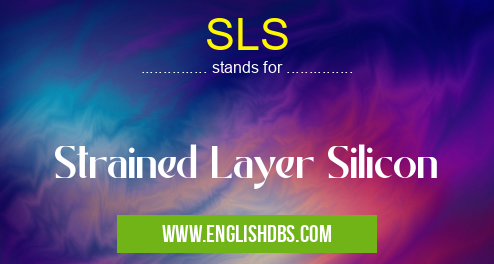What does SLS mean in ELECTRONICS
Strained Layer Silicon (SLS) is a type of semiconductor material used in the construction of integrated circuit chips for microprocessors and other electronic components. It provides a high level of performance and reliability due to its unique composition and structure. SLS is grown in a process called strained silicon epitaxy, which produces layers of Si atoms with an additional strain that gives it better electrical properties compared to traditional Silicon materials.

SLS meaning in Electronics in Academic & Science
SLS mostly used in an acronym Electronics in Category Academic & Science that means Strained Layer Silicon
Shorthand: SLS,
Full Form: Strained Layer Silicon
For more information of "Strained Layer Silicon", see the section below.
Essential Questions and Answers on Strained Layer Silicon in "SCIENCE»ELECTRONICS"
What are the benefits of SLS?
The main benefit of SLS is improved electrical performance characteristics such as faster switching speeds, increased operating voltages, higher levels of integration, lower power consumption and reduced device size. In addition, SLS has excellent structural integrity and can tolerate higher temperatures than other semiconductor materials.
How is SLS manufactured?
The manufacturing process used to create SLS involves growing layers of Si atoms on top of each other with an additional strain applied to them which increases their electrical properties. This is done by creating SiGe or GeSi layers within the substrate using methods such as molecular beam epitaxy or chemical vapor deposition.
What applications does SLS have?
Due to its improved electrical performance characteristics, SLS has been used in a variety of applications from smartphones and computers to wireless communications networks and automotive electronics. It also has potential uses in medical imaging where it can be used for more precise imaging resolution with lower power consumption than conventional silicon-based materials.
Are there any drawbacks to using SLS?
One potential drawback is that due to its complex manufacturing process, it can be expensive compared to traditional silicon-based materials. Additionally, since it requires cleanroom conditions for production, its use may come with the added overhead cost associated with maintaining such an environment.
How long will SLS remain viable?
Since new developments in semiconductor technology continue to drive improvements in performance characteristics across all types of materials, we expect that the use cases and viability of SLS will extend into the foreseeable future as cost effective processes continue to be developed for scaling its production capabilities.
Final Words:
In summary, Strained Layer Silicon (SLS) offers superior electrical performance characteristics over traditional silicon-based materials which makes them highly sought after for applications like smartphones and computers. It allows for better switching speeds, higher operating voltages, smaller device sizes and lower power consumption making it ideal for many industries where these features are essential for optimal operation. Although there are some drawbacks such as complexity in production resulting in potentially higher costs; overall this technology is expected to remain viable well into the foreseeable future due to advances in semiconductor technology continually driving down costs while increasing performance capabilities across all types of material structures.
SLS also stands for: |
|
| All stands for SLS |
